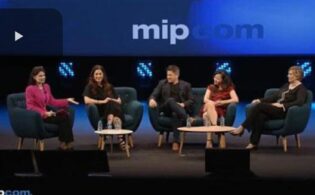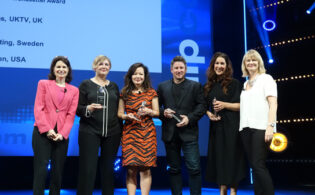Telia Company specializes in telecommunications and is active in the Nordic and Baltic countries, with its two main markets being Sweden and Finland. Among Telia’s holdings are TV4 in Sweden and MTV in Finland, as well as the streaming service TV4 Play. As director of programs and acquisitions, Cathrine Wiernik oversees three departments that are key to providing consumers with various viewing options, from free TV and cable to AVOD and different tiers of SVOD. As Wiernik tells World Screen, her teams’ focus is on fewer and bigger shows and their strategic placement on both linear and digital.
WS: Telia has media holdings in several countries, but looking at Sweden, the country with the largest population, what channels and platforms do you oversee?
WIERNIK: Focusing on Sweden, it’s TV4 and TV4 Play. We still have the smaller free-to-air channels and a handful of basic cable channels, but they’re not our main priority going forward. They are, of course, essential for our distribution business and a smart way to stretch and optimize rights through our ecosystem to increase consumption and drive traffic into TV4 Play. However, the most important thing is to keep increasing the digital footprint, so we have a 100 percent focus on building TV4 Play. We consolidated our two services one year ago; that was huge for us. We let go of C More, the pan-Nordic SVOD service and merged that with TV4 Play into one big local service. That’s done very well. It’s a broad local service for everyone, where we offer the full range of tiers. We have AVOD, which is completely free and carries most of our content, including news and local shows, all following the linear broadcast. Then we have SVOD with ad allowance (mini pay), where you can access our linear channels as well as previews of scripted shows and reality, and our ad-free tier, including the sports packages. So, whether you want something for free or are willing to pay for no ads, you can be in our universe.
WS: Starting with the linear channel TV4, what is the programming strategy, and what are the most popular program genres?
WIERNIK: We don’t have a strict linear strategy. We have one strategy that needs to feed both our linear and digital spaces, and these days, it’s definitely fewer and bigger. We need to cherry-pick more and focus our efforts on optimizing those titles throughout our ecosystem of channels and into TV4 Play. We don’t commission anything that we don’t feel has strong digital potential. It’s all about total delivery. Viewing of linear channels is rapidly decreasing and we still have to protect our linear revenues, but we do that with total viewing in mind. As long as a show delivers strongly or even stronger in the digital space, the total viewership is still what matters in the end. Overnight ratings are not as relevant today.
Being a national broadcaster, our spine consists of local content. News and sports aside, our main focus is on big entertainment shows—appointment TV—that bring in a broad audience without leaving the young ones out. We need to stay relevant in the younger demographics (20 to 44), as that is key to delivering reach. A few good examples are our versions of The Masked Singer, Solsidan (a scripted comedy) and The Traitors.
Another important genre is reality, such as MasterChef, Survivor, The Farm, The Bachelor, The Bachelorette, Farmer Wants a Wife and Love Island. We do a lot of stripped reality to feed the VOD platform and get viewers back daily. We also acquire the international versions (U.S., U.K. and Australia) of most of these big reality brands to help strengthen our business case but also to create continuity and a steady pipeline between the Swedish local series and give the viewers more of their favorite shows all year round.
Another genre that is important for us and has the potential to stick out and reach new viewers is documentaries. We’re not looking for volume but a high-interest, spectacular premise, like The Tinder Swindler. Anything between two to four episodes and a current topic with the potential to stick out in order to grab enough people. These are also published as box sets as the first episode is published on linear and tend to drive strong subscription numbers.
WS: Where does scripted programming fit into the mix?
WIERNIK: Scripted is a very important and central part of our mix. Consumption of scripted has increasingly moved to our digital platform over the last few years. It does super well on TV4 Play and is key to driving subscription sales. It has become an essential part of our subscription tier offering, where we release most of the titles a week or two before linear. However, we are now moving toward publishing all scripted series at the same time as linear to maximize the potential of the linear figures and avoid having to market the shows twice. Scripted has the potential to bring in broad numbers with a nice hit in younger demographics.
We have many established returning series that we’ve been building for many years, such as Beck and Sandhamn Murders. They’re very much a part of our scripted core and much loved by viewers, and we put a lot of effort into keeping the brands relevant and fresh. We also have our event dramas that are more serialized, normally between six and eight episodes, for example, Fallen (Sanningen), Riding in Darkness (Nattryttarna) and soon to premiere, The Doktrine (Doktrinen) as well as Cry Wolf (Vargasommar).
WS: How important are acquisitions for the group?
WIERNIK: They are a very good, cost-effective complement to our local programming. During the last decade, we’ve had an aggressive local strategy for our prime-time schedule. You wouldn’t see an acquisition in prime time. However, since the beginning of 2023, we’ve tried a few more acquired shows in prime time, as they are cost-effective compared to our local shows but also drive strong consumption on TV4 Play. U.K. light crime shows like Death in Paradise and Beyond Paradise are excellent examples. Danish crime also works very well for us; for example, Fatal Crossing (Nora Sand) and The Sommerdahl Murders.
Overall, acquisitions are key for TV4 Play, as they drive high consumption and help reduce churn. Many of these titles are published exclusively on our service with no linear window. A great example is Hayu, which is an exclusive offer on both our SVOD tiers and caters to reality fans in the younger demos. We acquire mostly English-speaking shows from the U.K., Australia and the U.S. and, of course, [series] from the Nordics (Norwegian and Danish). But we have also tried some European shows, for example, Turkish soaps. We’ve had an unexpected super success with Golden Boy. We did buy some Korean programs, both non-scripted and scripted, in the aftermath of the success of Squid Game, but it’s not a big acquisition strategy. It’s case by case. We try out a specific title to see if it works, then buy more.
We were not hugely impacted by the strikes in the U.S. because we don’t have output deals anymore. We’re not as heavily dependent on U.S. series volume-wise as we are moving towards fewer and bigger, but it’s still a very important part of our mix on a title-by-title level. For example, Yellowstone, The Rookie and From are performing very strongly for us. And we have great hopes for Brilliant Minds coming up next year. We are also seeing success with second-window acquisitions such as Yellowstone, and we are very open to looking at creative solutions around windowing and exclusivity. The market and viewing habits have changed massively in the last few years, and we need to adapt and stay flexible. Occasionally, in the spirit of fewer and bigger, when presented with the right title and package, we also allow ourselves to explore other models. A good example is Those About to Die, for which we are co-commissioners for the Nordics.
WS: So, despite recent challenges in the overall industry, are you optimistic about the future?
WIERNIK: The climate is so much harder today. We’ve been through an extremely tough 18 months. A significantly weakened ad market in 2023 forced us to cut costs and pause commissioning temporarily, which affected not just us but our partners in the production landscape. There’s been much less work, and it’s been tough for everybody. But this year, the ad market is picking up slowly. It’s not back to anything like it was a few years back, but it’s showing positive indications. We’re also back to commissioning more again—we’re in full swing with new commissions for 2025—and it feels like the industry is picking up as well. We see the light at the end of the tunnel, and there are positives to that. We’re on the other side of our reorganization. We’ve launched the new service successfully, and we’re seeing a lot of positive events that we’ve anticipated in digital. Also, in the aftermath of an overheated investment race both locally and globally, we’ve all had to adapt and realize that apart from investing heavily in content—which is still our key priority!—we also need to lean on a healthy, sustainable business model in order to recoup our investments. Somewhere on the other side of all this is a new normal that will be healthy for all of us and keep this industry and our viewers happy.


